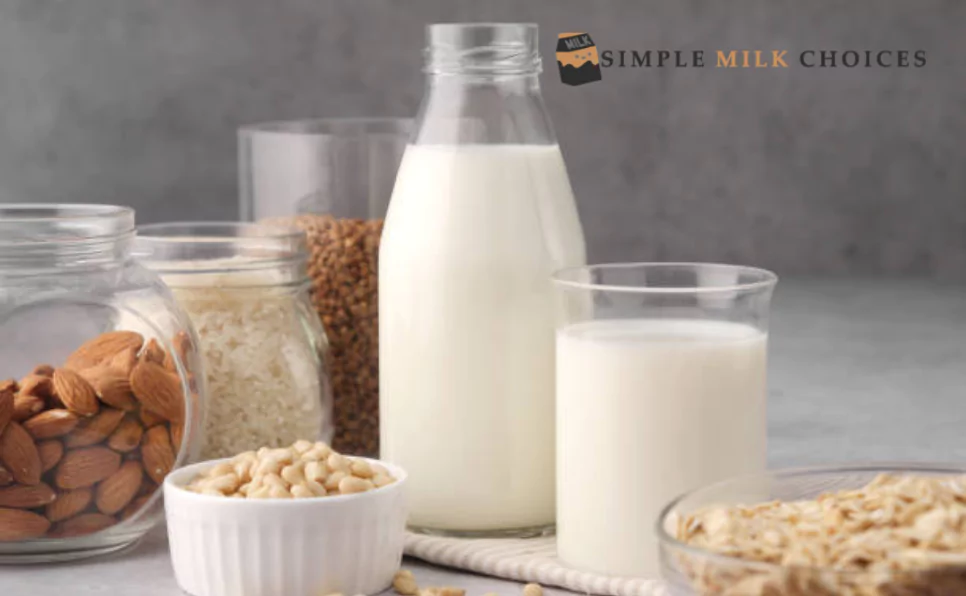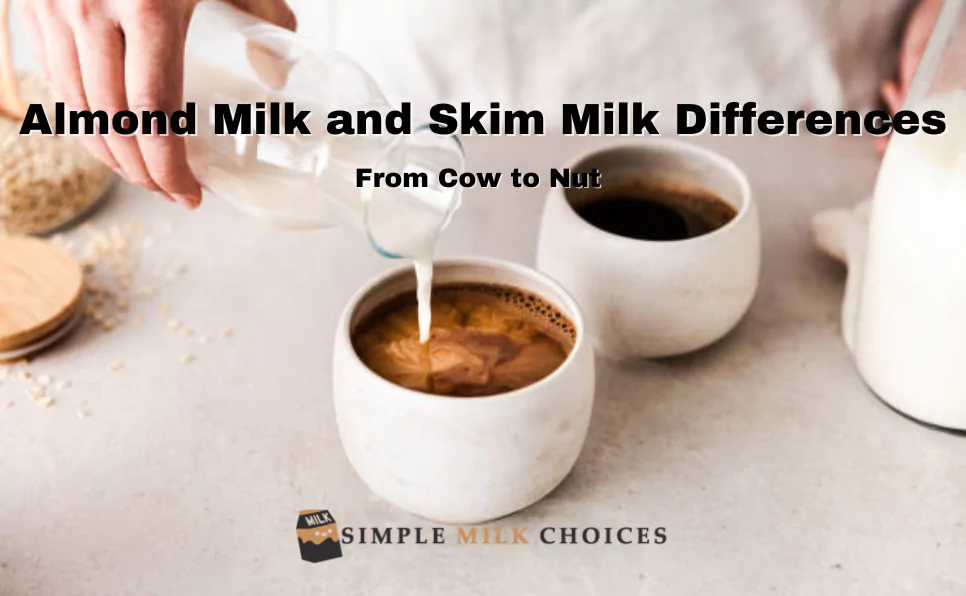The shift towards better way of life decisions has brought almond milk and skim milk into the spotlight as well-known options in contrast to traditional whole milk. This article tries to explore the differences between almond milk and skim milk, looking into their starting points, healthful substances, flavors, and different ideas for users.
Almond Milk: A Nutty Take-off from Dairy
Introduction to Almond Milk
Almond milk, a plant-based milk alternative, comes from ground almonds blended with water. Its notoriety has flooded because of its nutty flavor, adaptability, and rising interest in non-dairy choices.
The Almond Milk Creation Interaction
The excursion from one almond to milk includes mixing almonds with water, followed by stressing to eliminate solids. A few varieties incorporate sugars or strongholds for added wholesome advantages.
Wholesome Breakdown of Almond Milk
Almond milk is prestigious for being a low-calorie choice, offering unsaturated fats, vitamin E, and minerals. Understanding its supplement profile is pivotal for those looking for a supplement rich in dairy additives.
Skim Milk: The More Streamlined Dairy Choice
Introduction to Skim Milk
Skim milk, otherwise called fat-free or non-fat milk, goes through a cycle to eliminate the majority of the milk fat. It’s a staple in numerous families, esteemed for its lower calorie content compared with whole milk.
The Skim Milk Creation Process
The creation of skim milk includes isolating the cream from the entire milk, essentially lessening the fat content. This cycle brings about a lighter, less-fatty milk choice.
Healthful Breakdown of Skim Milk
Skim milk is valued for being a rich wellspring of protein, calcium, and other fundamental supplements. Understanding its healthful system is essential for people hoping to maintain a healthy eating routine.

Head-to-Head: Nutritional Comparison
Caloric Substance Correlation
Almond milk normally flaunts fewer calories than skim milk, making it an engaging choice for those aware of caloric intake. Understanding these distinctions assists people with making informed dietary decisions.
Protein Confrontation: Almond Milk versus Skim Milk
Skim milk starts to lead the pack in the protein division, offering a higher protein content compared with almond milk. This perspective is crucial for those focusing on protein consumption in their weight management plans.
Fat Matters: Almond Milk's Unsaturated vs. Skim Milk's Fat-Free Methodology
Almond milk’s unsaturated fats contribute to heart health, while skim milk’s fat-free nature lines up with low-fat dietary preferences. Unloading these distinctions helps consumers pick the milk that best suits their health objectives.
Vitamin and Mineral Substances
Beyond calories and protein, contrasting the nutrient and mineral substances of almond milk and skim milk gives a more extensive comprehension of their health benefits. Almond milk, plentiful in vitamin E and different minerals, offers one-of-a-kind advantages, while skim milk succeeds in giving calcium and other fundamental supplements important for bone health.
Dietary Contemplations: Sugar and Carbs
Looking at the sugar and carb content is crucial, particularly for those overseeing diabetes or checking their starch consumption. When it comes to choosing the best almond milk for lattes, opting for varieties lower in sugar might be a preferred choice for people with specific dietary restrictions. Almond milk is often a suitable alternative. Skim milk, while higher in carbs, remains a reasonable choice for those looking for a balanced supplement profile.
The Flavor Range: Almond Milk vs. Skim Milk
Almond Milk's Nutty Subtleties
Almond milk’s distinctive nutty flavor improves drinks, grains, and baked goods. Its flexibility adds a delightful twist to different recipes, making it number one among those looking for culinary innovativeness.
Skim Milk's Perfect and Gentle Profile
Skim milk’s gentle taste supplements both sweet and appetizing dishes without overwhelming different flavors. Understanding these flavor profiles helps people choose the milk that aligns with their culinary inclinations.
Beverage Affinity: Espresso, Tea and More
Taking into account the similarity of almond milk and skim milk with famous drinks adds one more layer to their flavor profiles. Almond milk’s nutty suggestions improve the experience of espresso and certain teas, furnishing a dairy-free elective with a distinct flavor. Skim milk’s perfect, gentle taste flawlessly incorporates into different drinks, offering an exemplary choice for espresso lovers and tea enthusiasts as well.
Consumer Inclinations: Overviews and Patterns
Understanding the advancing scene of consumer preference includes looking into reviews and the latest things. A few people might incline toward almond milk for its popular picture and plant-based taste, while others adhere to the commonality of skim milk. Examining consumer inclinations reveals insight into the elements impacting milk decisions in a powerful market.

Viable Applications: Cooking and Baking
Almond Milk in Culinary Manifestations
Almond milk’s light surface and nutty undertones make it a significant ingredient in cooking and baking. Heated almond milk, in particular, adds a comforting element to beverages and recipes, bringing out its unique flavor profile. Exploring its applications inspires chefs and home cooks to try different things with almond milk in assorted recipes.
Skim Milk's Adaptability in the Kitchen
Skim milk’s impartial flavor and consistency make it a flexible addition to a large number of dishes. Its utilization in cooking and baking upgrades the healthy benefit of dinners without settling on taste.
Surface and Consistency in Culinary Pleasures
Exploring the surface and consistency that almond milk and skim milk confer on culinary manifestations adds a material aspect to their functional applications. Almond milk’s smooth consistency lifts the lavishness of specific dishes, while skim milk’s lighter surface improves the cushiness of prepared merchandise. Understanding these subtleties guides chefs and home cooks to achieve the ideal mouthfeel in their recipes.
Recipe Makeovers: Adjusting Customary Dishes
Adjusting customary recipes to integrate almond milk or skim milk considers better options without forfeiting flavor. From smooth Alfredo sauces to wanton pastries, these milk choices offer material for recipe makeovers, taking care of different preferences and dietary requirements.
Health Contemplations: Settling on Informed Decisions
Almond Milk's Medical advantages and Contemplations
Almond milk offers potential medical advantages, from heart-solid fats to vitamin E. However, people should consider factors like sensitivities and caloric substances while integrating almond milk into their eating routines.
Skim Milk's Role in a Fair Diet
Skim milk’s protein richness and low-fat substance add to its role in advancing bone health and supporting general nourishment. Offsetting its advantages with individual dietary necessities guarantees an all-encompassing way to deal with health.
Digestibility and Gastrointestinal Considerations
Understanding what almond milk and skim milk might mean for digestion and gastrointestinal health is crucial, especially for people with responsive qualities. Almond milk, being plant-based, may be gentler on the stomach for those with lactose-narrow-mindedness. Skim milk’s lactose content might influence specific people in an unexpected way, requiring customized contemplations for stomach-related prosperity.
Long-Term Wellbeing Suggestions: Research Insights
Exploring long-term health suggestions includes looking into research concentrates that look at the impacts of almond milk and skim milk utilization after some time. From bone health to heart health, remaining informed about the most recent exploration insights guides people in settling on decisions lined up with their drawn-out wellbeing objectives.
Conclusion: Picking Your Pour
As we explore the different milk options, the decision between almond milk and skim milk becomes a nuanced one. Whether looking for a nutty curve in recipes or deciding on a more slender dairy choice, understanding the distinctions engages customers to pursue decisions lined up with their healthful objectives and taste inclinations. From the almond plantation to the dairy ranch, the excursion of these milk choices demonstrates the extravagance and variety of decisions accessible in the advanced time of sustenance.
Customized Nourishment Plans: An All-Inclusive Methodology
The conclusion underscores the significance of customized nutrition plans, recognizing that there is no one-size-fits-all arrangement. Tailoring milk decisions to individual inclinations, dietary necessities, and moral contemplations ensures a comprehensive way to deal with nourishment. Whether deciding on the nutty lavishness of almond milk or the clean simplicity of skim milk, consumers are urged to settle on decisions that reverberate with their extraordinary ways of life.
Remaining Informed in a Powerful Market
As the market keeps on advancing, remaining informed about new turns of events, item developments, and consumer experiences stays vital. Sellers confidently navigate the dynamic landscape of milk alternatives. They make choices aligned with their ever-changing preferences and values through continuous examination, nutritional updates, or emerging trends. This adaptability allows them to stay informed and responsive to the diverse preferences and values of their customers.
FAQ’s
What is the dietary distinction between almond milk and skim milk?
Almond milk is lower in calories and unsaturated fats and plentiful in vitamin E, while skim milk is a protein force to be reckoned with with a higher calcium content.
Is skim milk lactose-free?
Indeed, skim milk isn’t entirely lactose-free. It contains a modest quantity of lactose, but its levels are essentially lower than in entire milk. For more detailed information, here is a comprehensive guide about whether milk is lactose-free.
Which is better for weighting the board, almond milk or skim milk?
Almond milk’s lower calorie content might engage those monitoring their weight, while skim milk’s protein can help with satiety, supporting weight loss.
Can almonds be utilized as a substitute for skim milk in recipes?
Yes, almond milk’s light surface and nutty flavor make it a flexible substitute in numerous recipes, offering a dairy-free alternative to dishes.
Is skim milk vegan?
No, skim milk is not vegan, as it is a dairy product derived from cow’s milk. For more details, here is a comprehensive guide about whether skim milk is vegan.
What are the natural considerations of almond milk vs. skim milk?
Almond milk has faced criticism for its water-intensive cultivation. Skim milk, being a dairy product, has its own environmental considerations linked to large-scale farming practices.
Are there any allergen concerns with almond milk and skim milk?
Almond milk is a nut-based item, representing a gamble for those with nut sensitivities, while skim milk contains dairy, possibly influencing people with lactose-narrow-mindedness.





